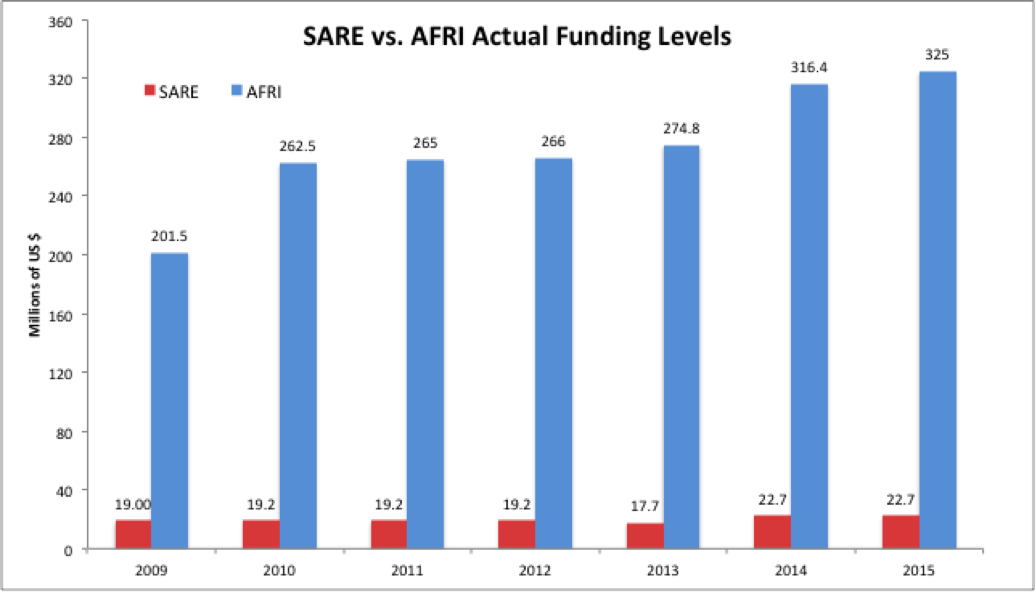Farmers are constantly innovating on their farms, and experimenting with new ways to control pests or boost yields or conserve water on their fields. Farmers’ bottom lines are at stake, especially new farmers getting started out. They have no choice but to find better, more effective ways to address the many challenges that Mother Nature and the market throw at them each and every year.
It’s this kind of farmer-driven innovation that first gave birth to the idea of creating a federal research program that takes advantage of farmer ingenuity by supporting sustainable agriculture research, including on-farm research that takes place in farmers’ fields and utilizes farmers themselves as researchers and innovators. After much hard work and grassroots advocacy, the Sustainable Agriculture Research Education (SARE) program was created in 1988, and since then, has been at the forefront of cutting edge farmer-driven innovations.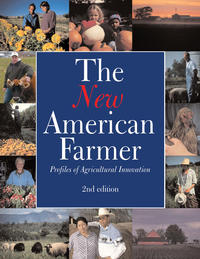
For example, few were researching cover crops 25 years ago and fewer still from a farming systems perspective. Research at academic institutions were more focused on boosting yields for individual commodity crops that increasingly relied on expensive chemical inputs. But farmers saw the nutrients and soil leaving their fields and were searching for ways to keep the soil in place over the winter months or boost soil health and fertility without chemical fertilizers. SARE was one of the first federal programs to support research on cover crops in a comprehensive way and continues to lead innovations in this area today.
Without programs like SARE, farmers today would be left with far fewer options to employ on their farms to manage pests and fertility in ecologically sound ways, and far slower exploration of new markets and value-added enterprises such as locally and organically produced food and grassfed meat.
Despite the impressive track record and the efficient, transparent, and outcomes-oriented research that has been funded through SARE over the past 27 years, the programs’ growth has been stalled in recent years. The lack of support from the Administration and Congress over the past few years has stymied investments in critical, farmer-driven research that is urgently needed to support the next generation of researchers and farmers.
Increases Needed for Publicly Funded Agriculture Research
The important role of agricultural research writ large in addressing pressing concerns of our time is hard to argue with. There has been a welcome renewed interest in public sector agricultural research funding and initiatives to address agricultural innovation, food security, global nutrition, and climate change, among many other focus areas. This shift comes at a time when private sector investment in agricultural research and development exceeds public sector investment.
Our blog from last week highlights several recent reports that discuss the importance of and changes needed to public sector agriculture research efforts.
Historical Research Trends
The US agricultural research system receives funding from three primary sources: Federal funds, State funds, and nongovernmental sources (primarily private-sector firms). These different funding sources have changed dramatically since the early 1970s, as seen in the chart below. In 1970, public and private agriculture research and development hovered around $3 billion for each sector, and in the late 1970s, private research and development overtook the public sector in investment amounts. The gap between public and private investments in agriculture research and development has fluctuated over the years, with the highest point in private R&D occurring in 1997.
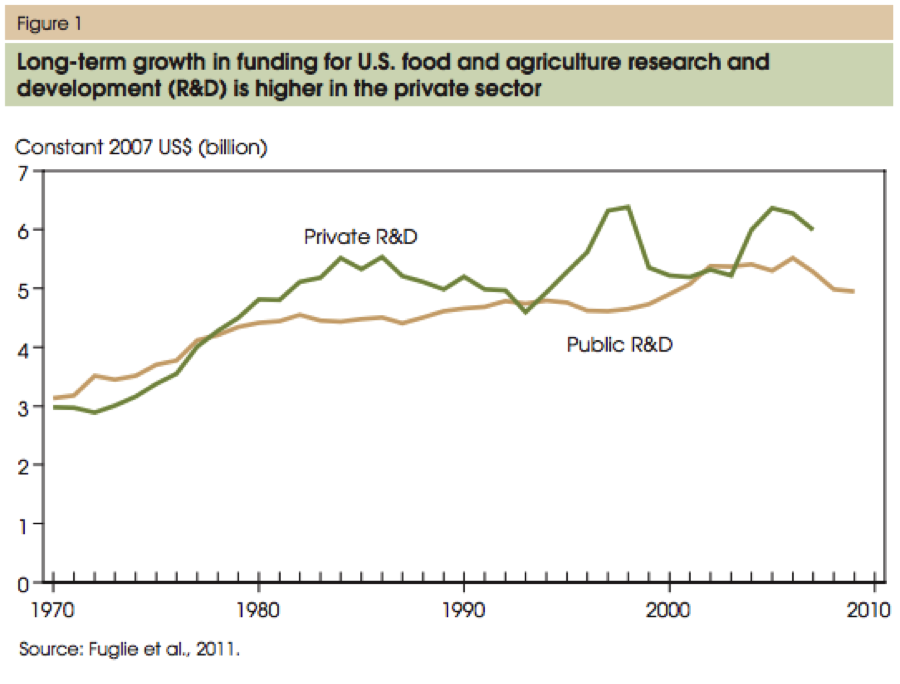
Public research tends to address a broader set of topics that private research, as private-sector firms focus their efforts on crops, food manufacturing, and farm machinery and engineering. Research on issues surrounding the environment and natural resources, human nutrition, food safety, and food policy will only continue if we expand public sector funding for agriculture research, including especially funding for programs like the SARE program.
SARE Research
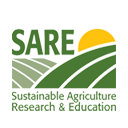 The Sustainable Agriculture Research and Education (SARE) program is the only USDA competitive grants research program that focuses solely on sustainable agriculture. SARE provides funding for farmer-driven research and is one of the most effective federal research programs in publicizing key research findings to farmers and other agricultural professionals in an accessible manner. SARE has been funding sustainable agriculture research for over 25 years through a unique regionally-based and outcome-oriented competitive approach. The SARE model involves farmers and ranchers directly in research as the primary investigators in smaller-scale on-farm research or as cooperators in larger research and education projects.
The Sustainable Agriculture Research and Education (SARE) program is the only USDA competitive grants research program that focuses solely on sustainable agriculture. SARE provides funding for farmer-driven research and is one of the most effective federal research programs in publicizing key research findings to farmers and other agricultural professionals in an accessible manner. SARE has been funding sustainable agriculture research for over 25 years through a unique regionally-based and outcome-oriented competitive approach. The SARE model involves farmers and ranchers directly in research as the primary investigators in smaller-scale on-farm research or as cooperators in larger research and education projects.
Countless farmers all across the country have benefited from SARE funding, and have contributed to the development of hundreds of research innovations that real farmers using sustainable growing practices can utilize on their farms. For example, as we recently profiled, SARE funds have allowed Blue Ridge Hops, a small family operation in Western North Carolina, to develop varieties and management practices for growing hops organically on a half acre of mountainous terrain. This SARE grant directly contributed to the establishment of the organic hops industry in the Southeast, and expansion to other parts of the country.
AFRI Research
Another important federal research program is the Agriculture and Food Research Initiative (AFRI) — the largest federal research program that provides competitive grants primarily to academic researchers to solve pressing challenges facing farmers and society. While SARE funds primarily applied research, AFRI provides larger and often longer-term research grants to support both fundamental (basic) research as well as more applied research, extension, and education projects.
AFRI projects are driven in large part by emerging research needs within the academic research paradigm, and are often more complex and expensive undertakings. AFRI research results are primarily published in scholarly journals and presented to scientific societies and other researchers in the field, though are generally not made directly accessible to farmers in the manner of the SARE program.
For example, AFRI funds have supported a transdisciplinary project among 11 institutions to assesses the environmental, economic, and social impacts of long-term climate variability on corn-based cropping systems. The project gathers data from more than 20 field test sites in 8 Midwestern states to focus on ways to best promote corn production and sustainability in the face of climate change.
SARE Funding Falling Further Behind
The SARE program annual funding levels are a fraction of the total dollars invested into AFRI.
SARE has grown from a $3.9 million program in 1988 to a $22.7 million program today. The 1990 Farm Bill authorized the SARE program as well as the National Research Initiative (NRI), the predecessor program to AFRI. In that year, Congress provided $4.5 million for SARE and $42.5 million for the NRI. By the time AFRI was authorized in the 2008 Farm Bill, SARE had grown to $19 million and NRI to $190 million, maintaining roughly the same proportional funding level between the programs.
AFRI on the other hand has grown quickly, from a $200 million program in 2009 to a $325 million program today, while SARE has stagnated at $22.7 million. Had the Obama Administration and Congress retained the same historic ratio between the programs, SARE today would be funded at roughly $32.5 million, or roughly 40 percent more funding that it actually has today.
The Administration’s funding priorities are typically communicated via the President’s Budget Request, which is published every February before the start of a new Fiscal Year. As can be seen in the chart below, the President’s funding requests for both AFRI and SARE substantially influence actual funding levels appropriated by Congress.
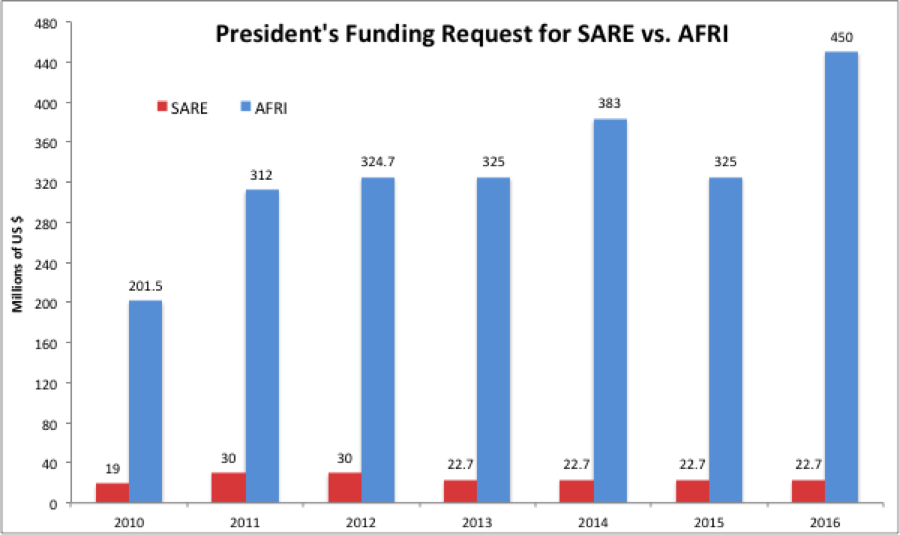
What is important to note, however, is that the funding requests for AFRI have increased significantly in recent years, while the request for SARE has remained flat.
The Administration’s request for AFRI has increased by 123 percent between 2009 and 2014, and while NSAC supports growing the larger agricultural research pie, we are deeply troubled by the lack of support for SARE in the President’s budget request. Over this same period, the President has only proposed a 19 percent increase for SARE, despite it being a much smaller pot of money.
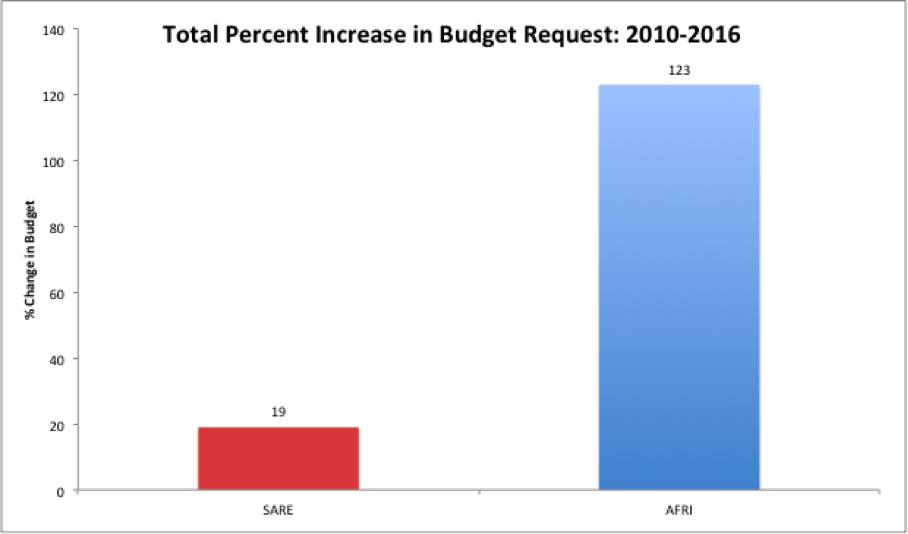
These requested increases in ag research funding translates to a meager $3.5 million increase in annual funding for SARE since this Administration took office, while an additional $123.5 million has been made available for AFRI-funded research.
What’s Next For SARE?
As the President’s budget request drives the actual funding of these critical research programs, it is absolutely essential that that the Obama administration push for increased funding for both competitive grant programs – SARE and AFRI – as it works to piece together its final budget request to Congress for Fiscal Year 2017.
In last week’s farmer fly-in, NSAC brought farmers to D.C. to urge USDA to demonstrate to Congress the need to grow USDA’s entire agricultural research portfolio by including a strong request for both SARE and AFRI in the FY 2017 Budget Request.
The current success rate for SARE research projects is just six percent of all proposals submitted for funding. This means that for every one successful research proposal, there are 16 proposals that go unfunded and are never able to be conducted. The potential research findings and new innovations that could be discovered is a significant missed opportunity that is stifling the growth and future success of more sustainable farming operations.
NSAC will continue to advocate to both Congress and the Administration that SARE be funded at at least $38 million in FY 2017. If we were to achieve this funding level, this would reflect an incredible federal investment in the next generation of sustainable producers by doubling the size and scope of the SARE program in the eight years that this Administration has been in office.


